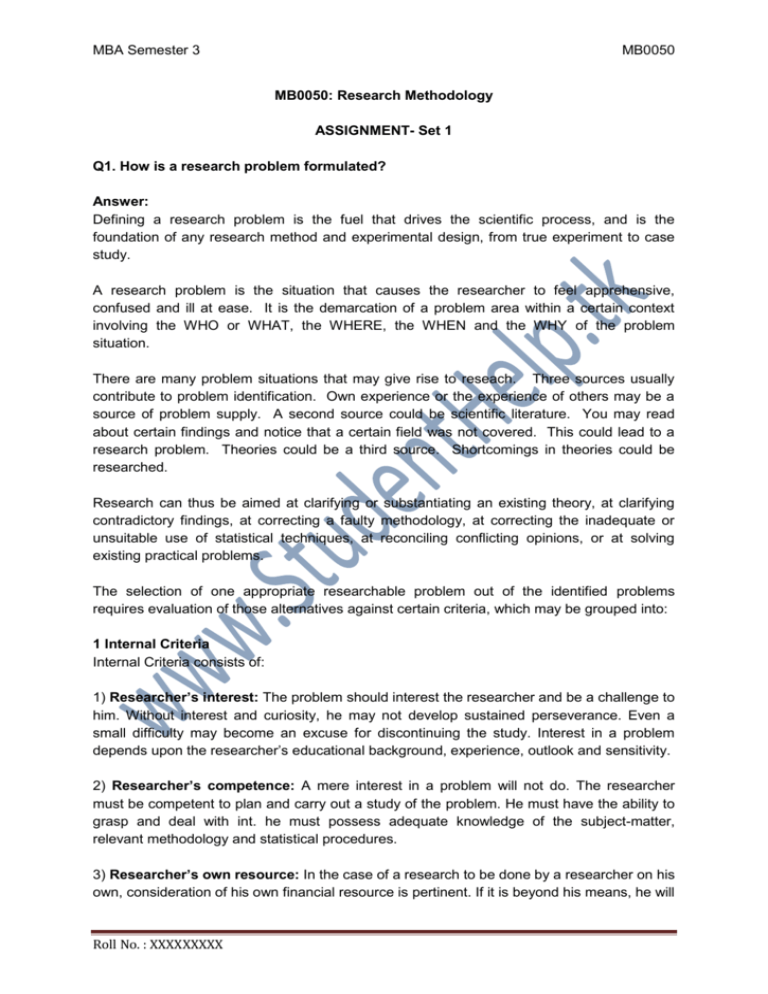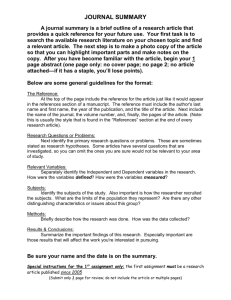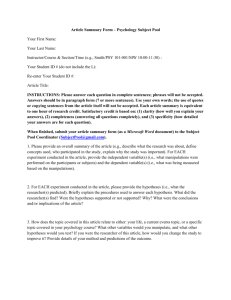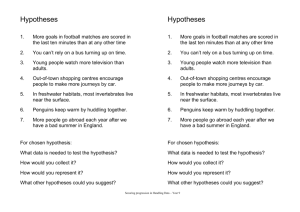Mba Sem3 Sample - SMU Assignment Answers | SMU Assignment
advertisement

MBA Semester 3 MB0050 MB0050: Research Methodology ASSIGNMENT- Set 1 Q1. How is a research problem formulated? Answer: Defining a research problem is the fuel that drives the scientific process, and is the foundation of any research method and experimental design, from true experiment to case study. A research problem is the situation that causes the researcher to feel apprehensive, confused and ill at ease. It is the demarcation of a problem area within a certain context involving the WHO or WHAT, the WHERE, the WHEN and the WHY of the problem situation. There are many problem situations that may give rise to reseach. Three sources usually contribute to problem identification. Own experience or the experience of others may be a source of problem supply. A second source could be scientific literature. You may read about certain findings and notice that a certain field was not covered. This could lead to a research problem. Theories could be a third source. Shortcomings in theories could be researched. Research can thus be aimed at clarifying or substantiating an existing theory, at clarifying contradictory findings, at correcting a faulty methodology, at correcting the inadequate or unsuitable use of statistical techniques, at reconciling conflicting opinions, or at solving existing practical problems. The selection of one appropriate researchable problem out of the identified problems requires evaluation of those alternatives against certain criteria, which may be grouped into: 1 Internal Criteria Internal Criteria consists of: 1) Researcher’s interest: The problem should interest the researcher and be a challenge to him. Without interest and curiosity, he may not develop sustained perseverance. Even a small difficulty may become an excuse for discontinuing the study. Interest in a problem depends upon the researcher’s educational background, experience, outlook and sensitivity. 2) Researcher’s competence: A mere interest in a problem will not do. The researcher must be competent to plan and carry out a study of the problem. He must have the ability to grasp and deal with int. he must possess adequate knowledge of the subject-matter, relevant methodology and statistical procedures. 3) Researcher’s own resource: In the case of a research to be done by a researcher on his own, consideration of his own financial resource is pertinent. If it is beyond his means, he will Roll No. : XXXXXXXXX MBA Semester 3 MB0050 not be able to complete the work, unless he gets some external financial support. Time resource is more important than finance. Research is a time-consuming process; hence it should be properly utilized. 2 External Criteria 1) Research-ability of the problem: The problem should be researchable, i.e., amendable for finding answers to the questions involved in it through scientific method. To be researchable a question must be one for which observation or other data collection in the real world can provide the answer. 2) Importance and urgency: Problems requiring investigation are unlimited, but available research efforts are very much limited. Therefore, in selecting problems for research, their relative importance and significance should be considered. An important and urgent problem should be given priority over an unimportant one. 3) Novelty of the problem: The problem must have novelty. There is no use of wasting one’s time and energy on a problem already studied thoroughly by others. This does not mean that replication is always needless. In social sciences in some cases, it is appropriate to replicate (repeat) a study in order to verify the validity of its findings to a different situation. 4) Feasibility: A problem may be a new one and also important, but if research on it is not feasible, it cannot be selected. Hence feasibility is a very important consideration. 5) Facilities: Research requires certain facilities such as well-equipped library facility, suitable and competent guidance, data analysis facility, etc. Hence the availability of the facilities relevant to the problem must be considered. 6) Usefulness and social relevance: Above all, the study of the problem should make significant contribution to the concerned body of knowledge or to the solution of some significant practical problem. It should be socially relevant. This consideration is particularly important in the case of higher level academic research and sponsored research. 7) Research personnel: Research undertaken by professors and by research organizations require the services of investigators and research officers. But in India and other developing countries, research has not yet become a prospective profession. Hence talent persons are not attracted to research projects. Each identified problem must be evaluated in terms of the above internal and external criteria and the most appropriate one may be selected by a research scholar. Objective of Formulating the Problem A problem well put is half-solved. The primary task of research is collection of relevant data and the analysis of data for finding answers to the research questions. The proper performance of this task depends upon the identification of exact data and information required for the study. The formulation serves this purpose. The clear and accurate statement of the problem, the development of the conceptual model, the definition of the Roll No. : XXXXXXXXX MBA Semester 3 MB0050 objectives of the study, the setting of investigative questions, the formulation of hypothesis to be tested and the operational definition of concepts and the delimitation of the study determine the exact data needs of the study. Once the exact data requirement is known, the researcher can plan and execute the other steps without any waste of time and energy. Thus formulation gives a direction and a specific focus to the research effort. It helps to delimit the field of enquiry by singling out the pertinent facts from a vast ocean of facts and thus saves the researcher from becoming lost in a welter of irrelevancies. It prevents a blind search and indiscriminate gathering of data which may later prove irrelevant to the problem under study. It helps in determining the methods to be adopted for sampling and collection of data. Techniques involved in Formulating Problem The problem selected for research may initially be a vague topic. The question to be studied or the problem to be solved may not be known. Hence the selected problem should be defined and formulated. This is a difficult process. It requires intensive reading of a few selected articles or chapters in books in order to understand the nature of the problem selected. The process of defining a problem includes: 1. Developing title: The title should be carefully worded. It should indicate the core of the study, reflect the real intention of the researcher, and show on what is the focus e.g., “Financing small-scale industries by commercial banks.” This shows that the focus is on commercial banks and not on small-scale industries. On the other hand, if the title is “The Financial Problem of Small-scale industries”, the focus is on small-scale industries. 2. Building a conceptual model: On the basis of our theoretical knowledge of the phenomenon under study, the nature of the phenomenon, its properties / elements and their inter-relations should be identified and structured into a framework. This conceptual model gives an exact idea of the research problem and shows its various properties and variables to be studied. It serves as a basis for the formulation of the objectives of the study, on the hypothesis to be tested. In order to workout a conceptual model we must make a careful and critical study of the available literature on the subject-matter of the selected research problem. It is for this reason; a researcher is expected to select a problem for research in his field of specialization. Without adequate background knowledge, a researcher cannot grasp and comprehend the nature of the research problem. 3. Define the Objective of the Study: The objectives refer to the questions to be answered through the study. They indicate what we are trying to get through the study. The objectives are derived from the conceptual model. They state which elements in the conceptual modelwhich levels of, which kinds of cases, which properties, and which connections among properties – are to be investigated, but it is the conceptual model that defines, describes, and states the assumptions underlying these elements. The objectives may aim at description or explanation or analysis of causal relationship between variables, and indicate the expected results or outcome of the study. The objectives may be specified in the form of either the statements or the questions. Roll No. : XXXXXXXXX MBA Semester 3 MB0050 Q2. What are the characteristics of good research design? Answer: Good research is not accidental. It requires careful planning as well as careful execution. Before launching a research project, social scientists prepare a research design, in which they set forth their plans for the research they intend to undertake. Often, such designs are formal in nature, as when a scholar prepares a research grant request to a funding agency, or when a student submits a proposal for a dissertation, thesis, or other research project. Even when a research design is not a formal requirement, it is a step in the research process that should not be bypassed. With a good design the student will be able to foresee and avoid numerous obstacles and pitfalls, save time in the long run, and produce a superior finished product. The length and complexity of research designs obviously vary considerably, but any sound design, be it for a massive, government or foundation supported study, or for an undergraduate term paper. The following are the Characteristics of a Good Research Design: 1. Identify the problem clearly and justify its selection. 2. Review previously published literature dealing with the problem area. 3. Clearly and explicitly specify hypotheses central to the problem selected. 4. Clearly describe the data which will be necessary for an adequate test of the hypotheses and explain how such data will be obtained. 5. Describe the methods of analysis which will be applied to the data in determining whether or not the hypotheses are false. 1. As you can see, step 1 requires you to state the problem and justify its choice; that is, you should explain your reasons for selecting it. It is correct to say that the choice of a topic depends principally on an investigator's interest and values. Nonetheless, there are some general criteria which we can use to evaluate the relative worth of topics. For example, how important is the topic for development of knowledge? How would the answer to questions which you pose for yourself affect other parts of the knowledge structure within political science? Would it extend "theories" to areas not yet explored? Would it replicate earlier findings in a different setting? Would it resolve present inconsistencies in our interpretation of evidence or create inconsistencies by calling into doubt currently accepted interpretations? A research project which adds to our knowledge in such ways is bound to be considered important. While the promise of acquisition of knowledge is an important criterion in evaluating research proposals, it is not the only standard we apply. If additional research on the problem will improve the social, political, or economic well-being of people, that fact helps justify the choice of a research topic. Would the answers to the questions that you pose for yourself affect the achievement of accepted social values? Might such answers cause changes in accepted social values? Positive answers to such questions suggest that the research proposal is one which is important. A third criterion which we use in evaluating a choice of research problems is the criterion of economy. How easily can the topic be studied? We are not likely to establish a moon colony simply to discover whether or not the relationship between sense of political efficacy and political participation which we've discovered repeatedly in Western nations persists among Roll No. : XXXXXXXXX MBA Semester 3 MB0050 those living on our permanent satellite. No one is likely to support a proposal to expend great amounts of time, skill, and money on a project likely to add little to our knowledge or to human welfare. 2. Before beginning any research project, you should familiarize yourself with the work that has already been done in your area, so that your project can build on and extend (or, if necessary, correct) the findings of those who have preceded you. A summary of this review of the literature should be included in your research design. Such a review is helpful not only in systematically gathering and organizing existing substantive knowledge about the topic but also in sensitizing scholars to the methods and procedures which have been used by others investigating the same general area. An increasing number of scholarly journals are now available online through the University of Toronto Library at www.library.utoronto.ca 3. The third major step in a research design is to clearly state the hypotheses to be tested. As used here, an hypothesis is a declarative statement positing a relationship between variables. In its simplest form an hypothesis contains these elements: an independent variable; a dependent variable; the nature of the relationship between the two. The development of hypotheses belongs to that area of inquiry which has been called the logic of discovery. The logic of discovery deals with the identification of good reasons for suggesting an hypothesis--reasons for putting it forward or testing it, not reasons for accepting it. One good reason for subjecting an hypothesis to test is that it is commonly believed. Gerald Pomper in his book, Elections in America, noted that the literature of political science was replete with claims that party platforms were unrelated to legislative enactments. Pomper also noticed that there was very little systematic evidence in the literature supporting the hypothesis; thus he decided to test it. His research falsified the hypothesis, which had been a standard one in political science, and therefore has been of great importance to the discipline. A second way in which hypotheses are developed is through the use of analogy. Hypotheses are often based on metaphors drawn from our environment. Darwin explained that it was his perception of the analogy between Malthus' theory of human population and processes in the animal kingdom which led him to develop the theory of evolution. The analogy between chess and international politics is an old one in political science, and in the last thirty years we have discovered that a careful study of games can be quite suggestive for the development of hypotheses regarding the ways in which nations treat each other. Another successful use of analogy in the social sciences is evident in the application of formulae developed to describe the spread of communicable diseases as formulae to describe the spread of rumors in society. Not all analogies are good ones. The test of a good analogy is that it suggests numerous and significant hypotheses and that those hypotheses are not refuted by systematic testing. A third way of developing hypotheses is retroduction. That method which Arthur Goldburg has defined "as an imaginative leap, a flight of fancy, taken to account for observed phenomena" is insufficiently understood. Many of you will know the tale regarding the discovery of Archimedes' Law that a solid body will, when immersed in water, suffer a loss in weight equal to the weight of the displaced water. As the story goes, Archimedes had long been perplexed by a problem set for him by the tyrant of Syracuse. He had commanded Roll No. : XXXXXXXXX MBA Semester 3 MB0050 that a votive crown of pure gold be prepared for placement in one of the temples, but gossip concerning the goldsmith suggested that some silver had been mixed with the gold in the manufacture of the crown. Archimedes was charged to discover without injuring the crown whether or not that was the case. The story continues that Archimedes, while taking a bath noticed that his limbs were unusually light when in the water and that in proportion as his body was immersed in the tub, the water spilled over its edges. That perception led to instantaneous realization that he could solve the problem. But if the myth has any basis, the fact that Archimedes after long study was hit so quickly by the solution to the problem that he was moved to leap out of the tub and run home naked shouting "eureka!" does not mean that the solution was not a result of his long study. Regardless of the way in which the hypotheses have been discovered or developed, it is crucial that they be stated clearly. If they are clearly stated, the distinction between independent and dependent variables should be obvious. Naturally, careful statement of the hypotheses also entails clear, conceptual definition of the major variables involved. 4. After you have stated your hypotheses clearly, you are ready to proceed to the fourth major stage in the research design, the description of the data required to check the hypotheses and the explanation of how the data is to be obtained. Your hypotheses determine in large part the kind of data required and suggest methods for collecting it. Let us assume that you plan to test the assertion that conservatism is related to social class such that the higher peoples' social class, the more likely they are to be conservative. Your first task is to operationalize the variables. How will you identify "conservatives" and "liberals" in terms of operations which others could repeat? How will you identify in similar terms a person's social class? Suppose you decide to operationalize conservatism on the basis of a scale based on a series of questions about political issues. You then need to specify the questions to be included in the scale and describe the method by which responses to those questions will be scored and summarized. Now what about social class? Suppose you decide to operationalize social class on the basis of income. Suppose further that you decide to group your data into the following categories: less than $15,000, $15,000 to $24,999, $25,000 to $49,999, and over $50,000. Your next step is to explain how the necessary data is to be obtained. In general, this might involve either primary analysis of data which you will collect especially for this project, or secondary analysis of data that has already been collected for some other purpose. In any case, the data that is to be analyzed must be described fully and accurately. The goal is to give readers sufficient information to allow them to successfully evaluate your proposed project and the analysis and conclusions which you will present later. The main point to remember is that in principle the data you plan to analyze must be capable of falsifying the hypothesis if the hypothesis is in fact untrue. What will count against it? That is probably the most important question in building theory. Indeed, the principle which should govern the selection of evidence to test the hypotheses is the principle that the chances of discovering decisive negative evidence should be maximized. The best design is one which would most clearly and quickly expose the error in a working hypothesis. That means that we go out of our way to look for negative evidence. Roll No. : XXXXXXXXX MBA Semester 3 MB0050 5. You are now ready to turn to the fifth major element in a good research design, the identification of the methods of analysis appropriate for treating your data. Be as specific as possible in describing the approach you will use, but do not propose to employ a technique that you do not really understand in the hope that this will somehow give your design an aura of erudition. For All Answers, visit: http://www.studenthelp.tk/ Roll No. : XXXXXXXXX








